Photo
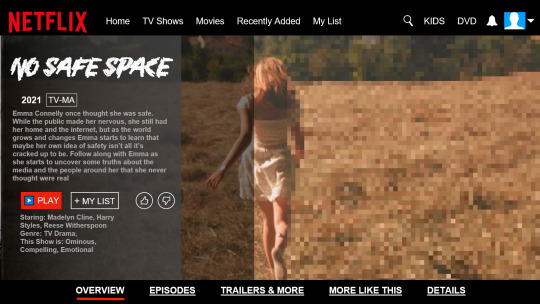
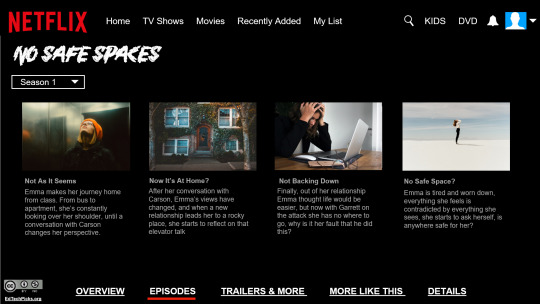

(click on photos to enlarge!)
REFERENCES
- Photos used in the Episode Guides
1. Photo by Mike Palmowski on Unsplash
2. Photo by Dylan Fout on Unsplash
3. Photo by Elisa Ventur on Unsplash
4. Photo by averie woodard on Unsplash
Links to news stories used for the More Like this page (shown in order of appearance)
1. CBC (March 30th, 2021) Victoria police looking for witnesses after woman attacked by 3 men. https://www.cbc.ca/news/canada/british-columbia/woman-attacked-by-three-men-1.5970283
2. Agostinelli, G. (July 5th, 2021). The Montreal Canadiens have legitimized rape culture by drafting Logan Mailloux. https://theconversation.com/the-montreal-canadiens-have-legitimized-rape-culture-by-drafting-logan-mailloux-165047
3. Henriquez, G. (July 26th, 2021). Vigil held in honour of presumed victim of conjugal violence in Montreal. https://globalnews.ca/news/8061897/vigil-presumed-victim-conjugal-violence-montreal/
4. World Health Organization. (March 3rd 2021). Devastatingly pervasive: 1 in 3 women. https://www.who.int/news/item/09-03-2021-devastatingly-pervasive-1-in-3-women-globally-experience-violence
0 notes
Video
Alright! Hello and welcome to the No Safe Space blog, I’m so excited for you all to get a closer look at the process of writing it!
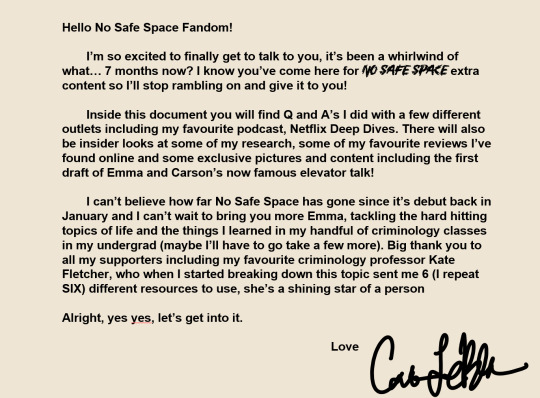
0 notes
Text
Episode 1: Not As It Seems
Hello!
Episode 1, done and over and you’ve met our main cast of characters including our lovely main character, Emma, who is going to go through many hardships and I still feel bad but it’s for the good of the people.
In these extra bits you are going to find a Q and A I did with the lovely Julia Morrow at Netflix Deep Dives, and we discuss my research into episode 1 and what I want you to take away from Emma’s story!
See you in the next one,
Catrina
0 notes
Audio
Below you can find the transcript for the above audio podcast episode!
-----------------------------------------------------------------------------------------------------------
Julia: Hello everyone and welcome to episode 205 of Netflix Deep Dives, I’m your host Julia Morrow and today we will be chatting with the writer and producer of Netflix’s newest mini series, No Safe Space, Catrina LeBlanc. Hello Catrina
Catrina: Hello Julia! It’s so good to be here this morning
J: So tell us a bit about No Safe Spaces, the quickest run down.
C: Well, No Safe Spaces is a four part mini series I created that follows Emma as she learns about the victimization of women and how the media, news, tv, internet, sort of gloss over some important things. Emma goes through all of these different places of victimization, and has a number of conversations about it and the respobsibilization of women when it comes to their own victimization, mostly in terms of sexual violence as we wanted to have a common thread through the story.
J: Well let’s just jump right in, let’s talk about the research for episode one, Not As It Seems
C: Not As It Seems is the episode we all know and experience. When you’re walking in a public space as a young woman, like Emma is on her journey home from class, you’re always glancing over your shoulder, looking at your surroundings to make sure no one is following you or watching you. My research for this episode was really personal experience, but also in the conversation between Emma and Carson in the elevator, you hear a bit about what I was trying to break down in this episode and that is while victimization in public exists, the media overrepresents and pushes it because of apparent news value it has.
J: News Value?
C: Yea, News Values. I’m not sure who popularized it but I heard about it in my class in an article by a criminologist by the name of Yvonne Jeukes, actually she might have been a sociologist but that’s besides the point, in one of her paper’s she talks about News Values which are value judgements that journalists make about public appeal of a story [1], crime in terms of news values is super interesting, there’s a public interest which beats this threshold of entertainment, there’s a risk for public safety, on and on.
J: So, you believe these news values push the idea of women being victims in public?
C: I do. While doing research for this episode, I stumbled across an article from a group of criminologists, Gray Cavender is the only one I can remember on the spot, the premise of it was about how gender is seen in reality crime tv, namely America’s Most Wanted, but I thought it could really be placed on news media as well. There was one main point I pulled out of this that is used in the conversation between Carson and Emma and that’s that “television construct narratives” makes tv accessible to people, (Carson basically talks about this in his opening statement). The article goes on to even say exactly what I want to say. I'm reading a quote here but, “According to Popular Discourse, women are vulnerable to victimization, especially if they venture into the public domain. Their assailants are strangers and frequently are poor, minority men who may be psychotic. These beliefs persist despite research revealing that women’s greatest victimization risk comes from intimates and family members” [2]
J: Are there statistics around this?
C: Actually yes, I had a sticky note over my desk, while I was writing this episode, it was from a study done in Massachusetts, sorry I can’t say that, but basically they looked at around 7000 cases of sexual assault where the assailant could be identified as either a stranger or someone they knew, 2000 of the perpetrators were strangers and 5000 were people known to the victim, sure this is one isolated look at one state, but to just throw away this information seems idiotic [3]
J: Oh wow, I always thought it’d be more likely to be the stranger
C: Most people do, if you turn on the news you’re looking at a woman getting stabbed in a park, I saw that on BBC the other day [4], or you’re looking at a woman getting beat up on the street after honking at a group of men, saw that on CBC [5], the news likes to push public victimization because it’s seen as this safety risk, our homes are seen as private space and so what happens behind them no one knows, I mean you learn that in ninth grade English reading To Kill A Mockingbird. “The things that happen to people we never really know. What happens in houses behind closed doors, what secrets” Miss Maudie says that. [6]
J: I remember reading that! So what do you want people to take away from episode one, why did you choose this as your first location?
C: I’ll start with why I chose the public as my first location, and it’s pretty simple - this is the one talked about the most, it’s sort of… dipping your toes into a discussion that not a lot of people want to expand on or have debate with. So I wanted to welcome people into the topic before starting to get into things that aren’t so mainstream, one’s that are a bit farther from my own personal experience. In terms of what I want people to take away, I think it’s simple, I want them to know that yes, the public can be scary, it’s ok to be nervous, don't let anyone take those feelings from you but also look at your media critically, even this story. We need to delve deeper into our understanding of victimization, of who a victim is. I didn’t talk about it so much here, but Emma is considered an ideal victim, she’s young, white, middle class, pretty, this is a description used for the ideal victim in so many academic articles, Cavender's article, this article blood lust and love that I used in episode 2. This show doesn’t really combat the idea of this white face of a victim, that’s not what I was trying to fight but I hope to do more of that in the next season.
J: Wow, so already have plans for season 2?
C: Oh definitely, but gotta get through season one first. We only talked about episode 1 here, make sure to watch episode two, but also please check trigger warnings, well there’s only conversation about sexual assault in this story, there is on screen assault in episode 2
J: Well, thank you for that warning, alright guys, that was episode 205 of Netflix Deep Dives with Catrina LeBlanc and her new mini series, No Safe Space, next episode we will be inviting Chase Stokes on to talk about the new season of Outerbanks
REFERENCES
[1] Jewkes, Y. (2011). The Construction of Crime News. In Media & Crime (pp.45-71). London: Sage Publications Ltd.
[2] Cavender, G., Bond-Maupin, L., & Jurick, N. C. (1999). The Construction OF Gender In Reality Crime TV. Gender & Society, 13(5), 643–663.
[3] Astion, M. (2008). Differences between Stranger and Known Assailant Sexual Assaults. Massachusetts: Massachusetts Executive Office of Public Safety and Security, Research and Policy Analysis Division
[4] Speakers' Corner: Woman attacked with knife (July 25th, 2021) https://www.bbc.com/news/uk-57965251
[5] Victoria police looking for witnesses after woman attacked by 3 men (March 30th 2021) https://www.cbc.ca/news/canada/british-columbia/woman-attacked-by-three-men-1.5970283
[6] Lee, Harper. (2006). To kill a mockingbird. New York :Harper Perennial Modern Classics,
0 notes
Text
Episode 2: Now It’s At Home
Hello hello!
So, was episode 2 your favourite? I still think episode one is mine, but that’s besides the point.
In these extra fun items for episode 2 you will find two LENGTHY discussions about my research for episode 2. I find that this episode is the one that packs the biggest punch because it’s the place of victimization that’s talked about the least - the home. This episode hits hard on topics of inter-partner violence and domestic abuse as well as rape/sexual assault, it’s certainly not for the faint of heart but I hope you walked away with a new understanding.
Below I’ve added the cover pages of the two main articles I looked at, they’re pretty beat up, but you can play my frustrations with academic articles for that
Have a lovey day,
Catrina <3
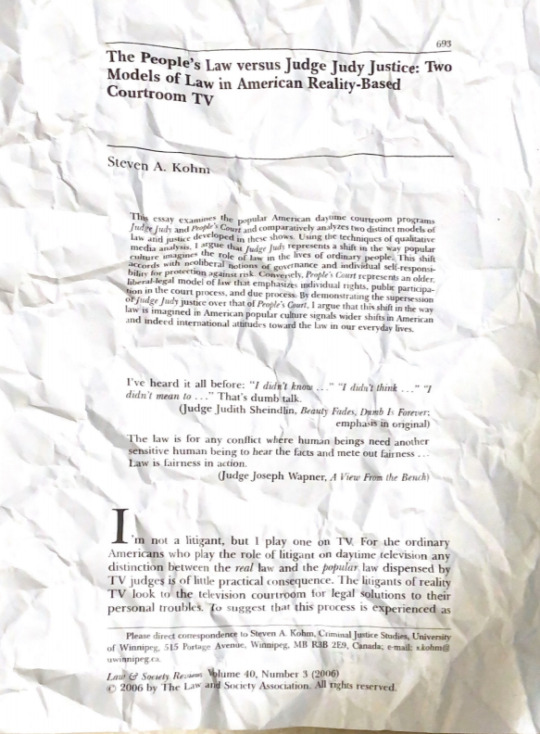
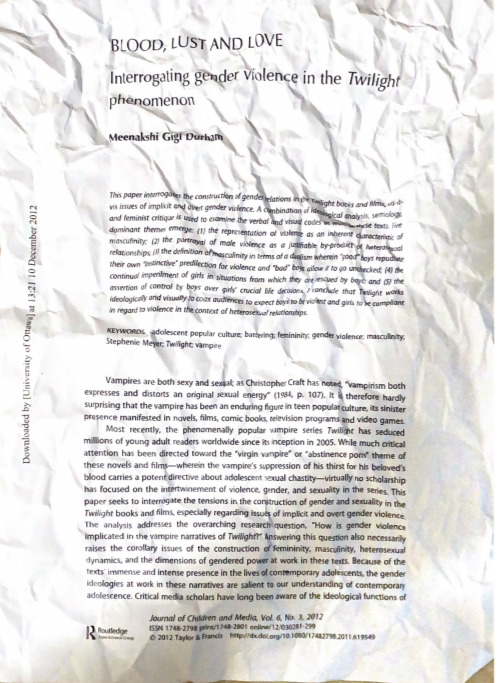
0 notes
Text
Episode 2: Now It’s At Home - Links to the Gendered Violence in Twilight!
Alright, now we’ve gotten through the first episode - Not As It Seems, we’ve dealt with the idea that maybe victimization in public has been sort of pumped up and dramatized by the media, we can see the statistics laid out before us, more often than not victimization is coming from within our relationships and at home.
This is where episode two moves, to talk about the victimization of women within the home. Now It’s At Home mostly follows Emma’s story as she gets into a new relationship with Garrett, a hockey player on her school’s team. The first scene after the hockey game involves them being at the bar and one of the girl’s mentions that hockey was said to be the most violent game at their school, i.e. the most violent players took part in it. This conversation was bringing about the idea in Durham’s article, Blood, Lust and Love about vampires being inherently dangerous, but controlling this feeling. The hockey players in this story are seen as the same when Emma spouts the line about how, “They keep the violence on the ice,” therefore controlling this sort of innate violence within them. I wanted people to be able to pull this parallel out of the story - but in this story instead of seeing Garrett like they see Edward, as this sweet, kind man for staying pure and not hurting Bella, I wanted the story to devolve, show Garrett as bad. Sort of fight the idea that well it looks good holding violence in, it isn’t.
Durham brought forth many ideas in her article, she also talks about one of the character’s Emily, and how the women was attacked by one of the werewolves but then ends up married and happy with him, this is never questioned in the novel, it’s yet another example in twilight where violence against women is just sort of brushed off because men are sweet, this is seen so much in real life and in this story as well. Garrett hits Emma after a loss, she says that maybe they just needed to try harder next time and he back hands her, but the next day he sends her flowers and everyone says he just slipped it up, it was an accident. All of these things are used to show the normalization of violence in our current society and looking at it when reading something like Durham’s article shows that the media simply reflects and reinforces these ideas of violence in heterosexual relationships and that violence can be overlooked for the right reasons

(Original note taking by me ^^ from the Blood Lust and Love article on the Emily situation)
All together I used Durham’s article as a backboard to jump off the ideas of heterosexual relationships being inherently dangerous (evidence from article in my below note :)), at least when viewed in the way that media shows them. I think it’s important to try and challenge this idea that violence is normal. We hear it all the time, boys will be boys, but we don’t need to accept it and hopefully in Carson’s monologue on why Emma should leave, you’re able to understand that. “No one who loves you, should be hurting you, violence is never right, would you hit something you love? No, then why would you let someone you love hit you.”
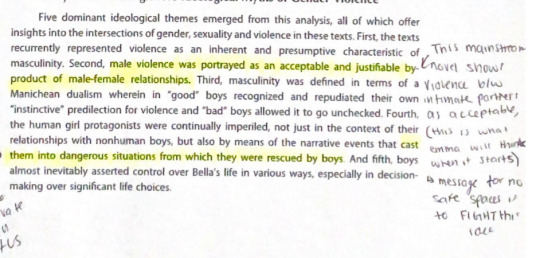
A novel like twilight was never really questioned, the books was seen as a “sweet love story” and really nothing more, but it reached a vast majority of a young population and without even trying changed their views of relationships. Another important aspect that Durham pulls out is the idea of Bella and Edward’s relationship being far from a sweet love story, but actually showing, and normalizing, ideas of inter-partner violence. In Durham’s article she talks about when Bell and Edward finally have sex and it ends up with Bella looking “battered.” She ends up having to hide her bruises and it perpetuates this idea that violence is just normal in heterosexual relationships.
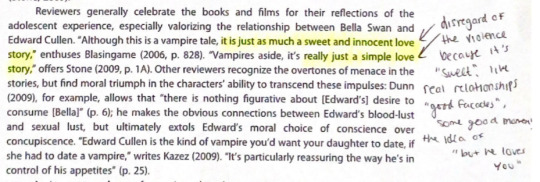
I pulled this idea out and put it within No Safe Space as well. Obviously we see Emma hiding her bruises, a number of times - after sex at the party, when they go to her parents house - but unlike twilight, I wanted to make sure this was seen as bad, Emma always looks upset when seeing the bruises, she winces when she moves, she flinches when Garrett moves near her, all of these are done in order to show that divide between Bella and Emma, Bella loves Edward despite these things, but Emma can’t, she hurts and knows this is bad.
Go onto the next post to see the other article I used for this episode!
REFERENCES:
Durham, M. G. (2012). Blood, Lust, and Love. Journal of Children and the Media, 6(3), 281-299.
0 notes
Text
Episode 2: Now It’s At Home - Women are Responsible :(
Something that I felt needed to be brought into the episode on victimization of women at home was this idea I learned about in my criminology class which inspired this whole show! This idea is that in a neo-liberal society a person is responsible for what happens to them because if they’d been doing what was right, and self-policing nothing would have happened (simplified version of the idea, but you get it)
This topic came about while we were talking about Judge Judy. You’ve heard of her, you might even love her (I can’t stand her), but she’s a female judge with her own show which people come before her in court and she decides their fate, she doesn’t really use the law, but instead her own morals to make decisions. I learned mostly about her show through an article entitled The People’s Law versus Judge Judy Justice written by Steven A. Kohm. It’s a long intricate academic article so I’ll just tell you about the pieces I pulled out of it in order to help write Now It’s At Home.
One of the pieces I pulled inspires a conversation between Emma, and her casual friend, Lia, the two are chatting and Emma is finally starting to open up about what’s going on with Garrett, her constantly saying no and him never listening, the bruises he’s leaving on her. Lia laughs everything Emma’s saying off, saying that well maybe Emma should stop saying no, because either she get with it or she kicks him to the curb, all the while rolling her eyes and sort of.. taunting Emma. This whole thing was inspired by some of the things that were being said by Judge Judy including “unless you enjoyed the fighting and making up. I’m not so sure. But you’ve gotta smarten up!” and “But you’re also a dope. It’s time for an eye-opener” [1] Both of these are said to women who are in abusive situations, Judge Judy basically says that the women aren’t smart enough to get out of these bad situations, this leans towards victim blaming and making their women responsible for the own assault, which in my opinion is freaking horrible, but that’s what this society leans towards, self-policing and street smarts.


We even see this in the quote I talked about last post, about Carson’s conversation with Emma, his exact wording is, “Why would you let someone you love hit you then.” He didn’t mean anything by this, I wrote him I know, but it’s something that anyone would say, because even if you don’t think it, you do think that women have some responsibility for what happens to them.
In an article I talked about during Episode One, there was a topic spoken about that women who are raped by sexual partners, ones that they know, aren’t seen as real victims, [2]

This falls more into an idea I haven’t talked about but it’s Hegemonic masculinity and Emphasized femininity, well I haven’t stated these terms they’re really entwined in everything we’ve talked about. Hegemonic masculinity is the ideal idea of a man, strong, intelligent, that violent tendency always lingering, Edward Cullen, if you want to pull twilight back into it. Emphasized Femininity is the opposite of this, sexually passive, nurturing, caring, think of the idealized version of a housewife in the 50s. So, if a women in this society is supposed to be sexually passive, her saying no to a partner, well she’s doing something wrong, she’s breaking this mold and making herself an other, that’s what all of this does, it creates these poor women who are being abused into others and it’s seen as their own fault. It’s such a stupid idea that so many of us think we’ve grown past but it’s always there, in real life and in the media.
The neo-liberal society that we live in pushes towards a privatization of our lives as well as a responsibility to ourselves, it’s our duty to look after ourselves even if it’s someone doing the abuse unto us. It’s a wicked and messed up place we live in and I wanted to break that down by having Carson help Emma out of the situation, I wanted to show people, be different than that horrid judge Judy, that there’s somewhere there to help and not everything rests on our own shoulders.
I hope you enjoyed this look into my research for this episode and it encourages you to dive in deeper!
REFERENCES
1. Kohm, S. A. (2006). The People’s Law versus Judge Judy Justice: Two Models of Law in American Reality-Based Courtroom TV. Law & Society Review, 40(3), 693- 727.
2. Cavender, G., Bond-Maupin, L., & Jurik, N. (1999). The Construction of Gender in Reality Crime TV. Gender and Society, 13(5), 643-663. Retrieved August 4, 2021, from http://www.jstor.org/stable/190327
0 notes
Text
Episode 3: Not Backing Down
Hola!
Episode 3, the internet. I did a poll a few weeks before starting writing No Safe Space, because I was curious if people actually felt unsafe on the internet, personally I never had, and after taking the class that inspired this whole show, it seemed that the media wanted us to be afraid? I don’t know, so I took a poll asking about it, there was 19 responses and I’ll leave the little graph below for you to peruse!
This episode, Not Backing Down, focuses on the responsibilization of young women when it comes to sexting (Sort of the main focus it seems when talking about crime and the internet, at least when it comes to young people) and the method people believe young women should use when bad things happen, leaving and backing down.
But I leave you with the question, before you get into the extra content, are you scared of the internet?
See ya on the flip side
Catrina
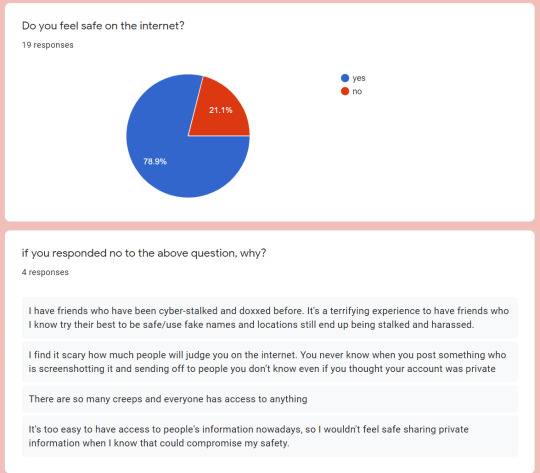
0 notes
Text
Episode 3: Not Backing Down
All of the episodes of No Safe Space are centered around locations of victimization. The last episode, Not Backing Down, is usually labelled as the internet, and well this is true it focuses a lot on sexting. My research centered around a campaign in 2011, when an activity book was created by the Canadian Centre for Child Protection entitled Respect Yourself, it felt rather juvenile, but was a book aimed at teens about sexting. The main message was, you should RESPECT YOURSELF enough to not send these pictures/explicit messages. While writing this episode I created a sort of infographic while using canva to map out and understand how I wanted to use this information (it shows my link between Logan Mailloux and what happens between Emma and Garrett - show the information I pulled from two different articles (referenced at the bottom of this post), so that’s the extra tidbit below (hopefully you can tell design is my passion lol) - the colours are based off of the original workbook, it had kinda a cute theme.
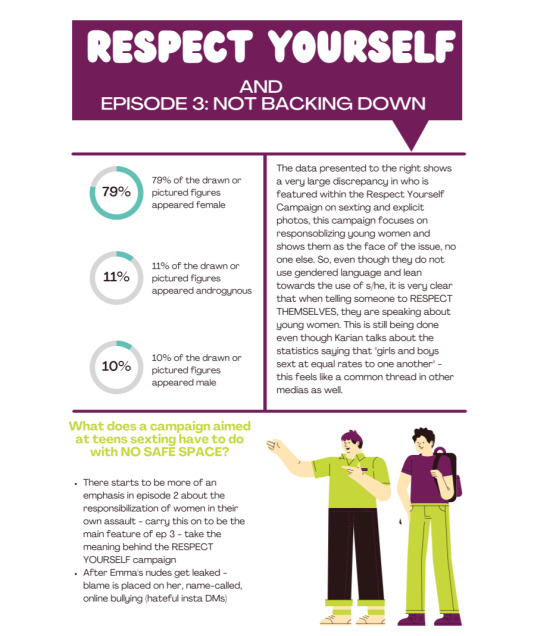
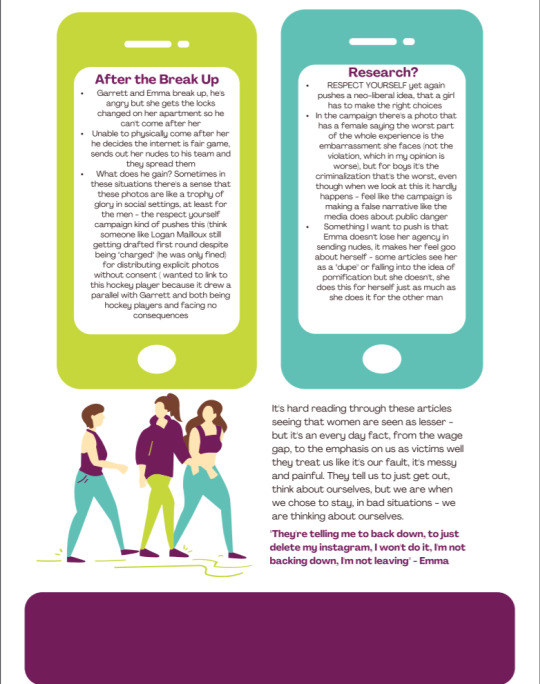
(Click to enlarge photos!)
REFERENCES
( Other than colour scheme - any information about the respect yourself campaign came from Karaian’s article )
Karaian, L. (2014). Policing ‘sexting’: Responsibilization, respectability and sexual subjectivity in child protection/crime prevention responses to teenagers’ digital sexual expression. Theoretical Criminology, 18(3), 282–299. https://doi.org/10.1177/1362480613504331
Karaian, L. (2012). Lolita Speaks: “Sexting”, Teenage Girls and the Law. Crime Media Culture, 8(1), 57-73.
Agonstinelli, G.(July 26th, 2021) The Montreal Canadiens have legitimized rape culture by drafting Logan Mailloux. From The Conversation https://theconversation.com/the-montreal-canadiens-have-legitimized-rape-culture-by-drafting-logan-mailloux-165047
0 notes
Text
Episode 4: No Safe Space? Final Wrap Up
So, we made it here. To the end of our 4 part mini series. We’ve seen victimization in public, in private and even on the internet (or at least through this eerie thing we call cyberspace).
We follow Emma as she comes home from class, scared of what might happen. Here she learns in a discussion with Carson that the media creates a bigger deal about getting jumped or grabbed or assaulted in public that it actually is. Sure this doesn’t stop her from being nervous, it never does, but it causes her to do more research, to start to understand that the media well it doesn’t fabricate things, chooses to push forward ideas to which the public have more interest and in the case of victimization it’s from strangers.
Episode 2 brings about the type of victimization which in their discussion Carson says is most common, victimization at home from intimate partners. In my interview with Julia you hear about these statistics, that yes, it is more likely to be a partner. Another choice for the title of this episode was going to be How Could This Happen To Me, it was going to show that people don’t think that it’s going to happen to them, that their partners are going to turn violent, but Emma’s does. Her new relationship with Garrett pulls on a few different elements I found, from the aggression of a vampire to the implicit violence in heterosexual relationships which is talked about in the article Blood, Lust and Love. This episode also starts to talk about the idea of responsibilization of women when it comes to their own assaults and just violence against them in general. We took a look at my research with an article on Judge Judy and how this main stream figure shows the ideas of a neo-liberal society, how everyone needs to self-police and nothing bad will happen, and when you don’t, well you must be a “dope.” Episode 2 does end up with the eventual break up of Garrett and Emma, after she talks to Carson and he convinces her that what she’s going through isn’t normal.
Episode three is our episode on internet victimization, but focuses mostly on the responsiblization of girls and women when it comes to sexting. In this episode Garrett releases nudes that Emma had sent to him while they were in a relationship. When people see them Emma is seen as the slut, the bad guy. These ideas while pulled from real life were also pulled from real data from articles on campaigns like RESPECT YOURSELF, a government campaign looking to stop kids sexting but really all it does is make girls responsible for what people do with those images. It has an overarching message that if the girl had never sent the photo nothing would have happened.
After all of this, what does episode 4 bring us. I think it bring a bit of closure. The whole episode takes place in one day. Emma leaves the city by herself and drives out to the beach. After everything that’s happened over the 4 episodes (basically a semester) she’s tired and worn down, there doesn’t feel like there’s a point anymore. In this episode I just kind of called on my own feelings, in this moment how would I feel? And I knew the best answer was tired because that’s how I felt after the discussions of these topics in the class that inspired this story. I felt tired that time and time again I, as a woman, was either being lied to or made responsible for atrocities that could happen to me. I wanted to showcase that in Emma.
At the close of the episode I thought about having Emma kill herself, she was just so tired after everything that had taken place, she was thinking about the fact that it was always going to be like this, that it was never going to stop, but when I went in a search for the causes of women’s suicide - I found that there’s not a lot of research on it, it seems that male suicide is overrepresented in the media [1] and this just felt like yet another place women weren’t being seen - sure it was something bad but still it could help other women. When I found this out I decided no, Emma wouldn’t die, she would help. She would turn her exhaustion and anger into action, so in the flash forward you see her working at a clinic, helping to educate.
I wanted Emma’s story to show that things do get better, that well we have all this shit reigning down on us so do other women and we can stick together and create a safe space amongst us in order to feel scene. So is there No Safe Space for women? Maybe, but maybe we can work at creating one together.
REFERENCES
1. Mallon. S. (2019). An exploration of the dynamics of suicide among women. HSC R&D Division of the Public Health Agency. https://novascotia.cmha.ca/wp-content/uploads/2019/11/4_An-exploration-of-the-dynamics-of-suicide-amoung-women.pdf
0 notes